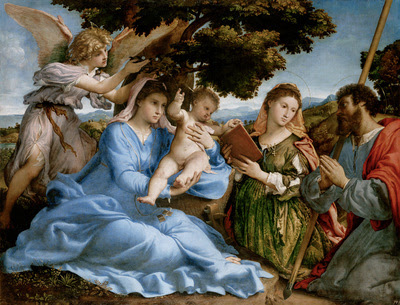In my interpretation of Giorgione's Tempest as "The Rest on the Flight into Egypt" I explained the reasons why Giorgione chose to portray St. Joseph as a virile, young man. Shortly after Giorgione's death, contemporaries like Paris Bordone, and Lorenzo Lotto also depicted a virile, youthful St. Joseph in versions of the Mystic Marriage of St. Catherine. Here is a discussion of Lotto's version. |
Lorenzo: Mystic Marriage of St. Catherine
|
A painting by Lorenzo Lotto of the Mystic Marriage of St. Catherine provides another example of a young, virile St. Joseph by a contemporary of Giorgione. The painting is in the Kunsthistorisches Museum in Vienna where the man, formerly identified as St. James is now identified as St. Thomas. He kneels next to St. Catherine who gazes at him and not at the infant Christ. They are obviously exchanging vows., and it can only be St. Joseph who acts as a proxy for the marriage of the infant Child, and the legendary Queen of Alexandria. Joseph is shown with his staff but his virile good looks and the spear-point at the end of the staff have led scholars astray.
In his work on Lotto, Bernard Berenson identified the kneeling man as St. James the Greater but provided no explanation. In the catalog of the 1997/1998 Lotto exhibition at the National Gallery of Art in Washington, Peter Humfrey identified the man as St. Thomas because of the spear.* A decade later in the Bellini, Giorgione, Titian exhibition in Vienna, however, the man was still identified as St. James. There is no good reason for either St. James or St. Thomas to be in the desert participating in the mystic marriage of St. Catherine.
On at least two occasions, and at about the same time as Lotto, Paris Bordone painted the mystic marriage of Catherine with a rustic-looking, vigorous Joseph playing a prominent role.

One of Bordone’s versions was featured in the same Bellini, Giorgione, Titian exhibition. In that painting Joseph’s muscular, bare foreleg is evidence of his role as the proxy for the mystic union of Catherine with the Christ child. The other version is at the Hermitage and also features the muscular, bare leg. In that version the Madonna has already passed the infant Christ to Joseph.
In Lotto’s painting the Madonna holds the child out to observe the ceremony. In the Lotto catalog Peter Humfrey noted that the painting “is first recorded by Marco Boschini in his 1660 Venetian dialect poem La Carts del Navigar Pittoresco.” Boschini identified the man as St. Joseph. "The majesty to be found in the venerable and devout old St. Joseph is for me expressed by only one brush: a brush that is most singular and memorable!"
Boschini’s description of Joseph as old, “vechiarelo,” is belied by the saint’s dark beard, full head of hair, and robust physique. In Humfrey’s opinion Boschini’s “accurate evocation of the pictorial qualities of the work is remarkable,” but he claimed that the identification of St. Joseph was “mistaken.” Humfrey believed that it was unlikely that Boschini had actually seen the painting in person, and that the spear-point told against St. Joseph. It is true that a point on the end of Joseph’s spear must be explained but on the whole it is much easier to explain that small item than it is to explain the presence of either St. James or St. Thomas at the marriage of Catherine, or the absence of St. Joseph from this familiar scene.
Years after writing this post in 2011, I can only guess that Joseph's protective role had assumed a martial aspect. The Man in the Tempest was called a "soldier" by a Venetian observer two decades after Giorgione's death mainly, I believe, because of his pose. But he carried a staff, a tradition associated with St. Joseph. For some reason, followers of Giorgione added a spear point to the staff, or even turned it into a halberd.**
 |
Palma Vecchio or follower
Philadelphia Museum |
###
*Lorenzo Lotto, Rediscovered Master of the Renaissance, New Haven, 1997. Catalog #31. “Virgin and Child with Saints Catherine of Alexandria and Thomas,” c. 1528-1530, oil on canvas, 113.5 x 152, Kunsthistorische Museum, Vienna.
** See the discussion of this painting in the previous post at Giorgione et al..


